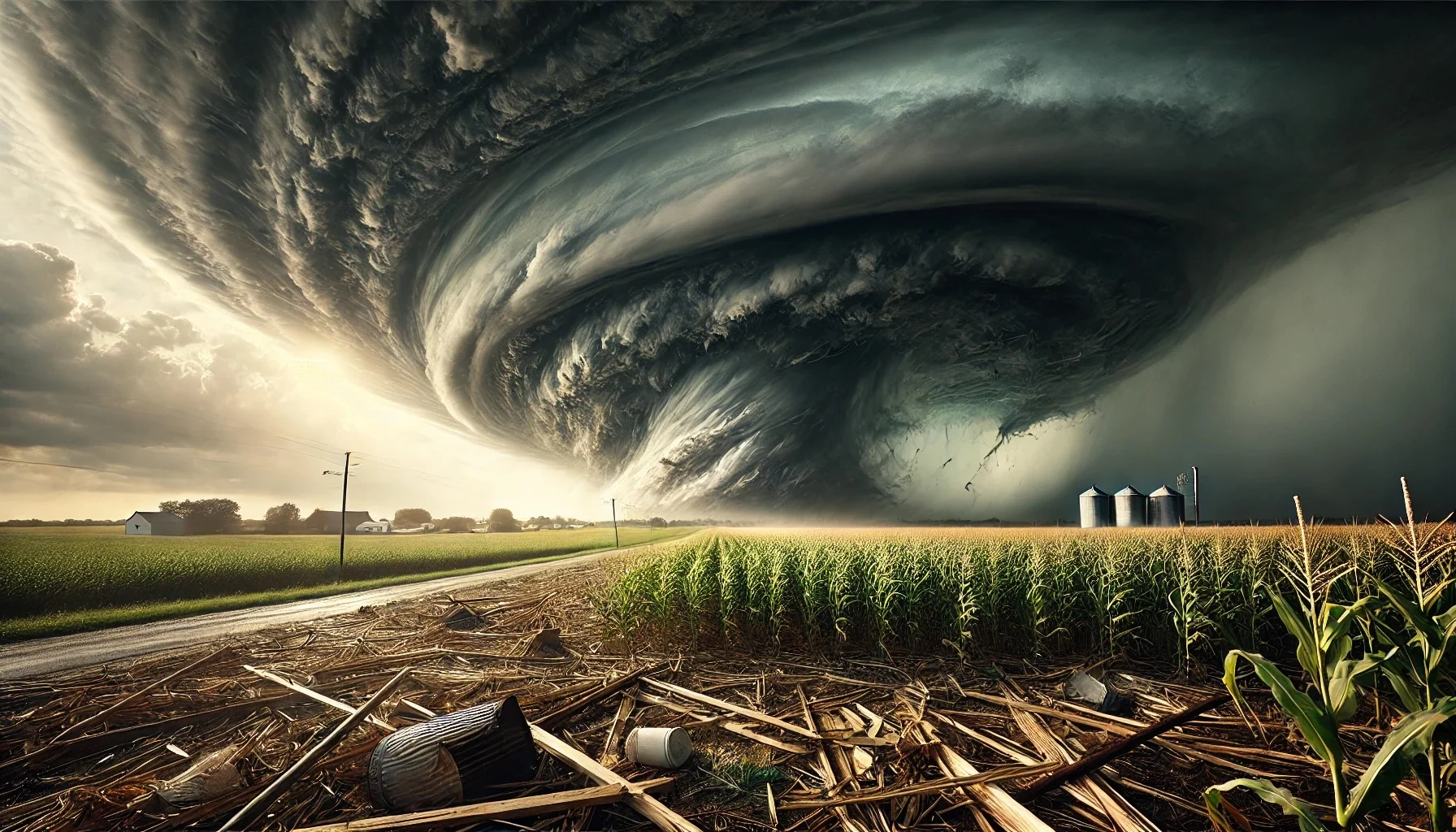
The 2020 Midwest Derecho
by: The Calamity Calendar Team
August 10, 2020
The Birth of a Storm
In the quiet early hours of August 10, 2020, a brewing storm was beginning to form over eastern Nebraska. As temperatures soared and humidity hung heavily in the air, conditions were ripe for an atmospheric phenomenon that would soon make history. This was no ordinary storm; it was a derecho, a rare and formidable type of storm capable of unleashing fierce, straight-line winds over vast distances. By mid-morning, the storm had intensified, setting its sights on the heart of the Midwest.
What is a Derecho?
Derechos are powerful, long-lived windstorms associated with a rapidly moving band of showers or thunderstorms. Unlike tornadoes, which feature rotating winds, derechos produce straight-line winds that can cause widespread and significant damage across large areas. The August 2020 derecho was especially severe, driven by a combination of extreme summer heat and unstable atmospheric conditions typical of the Midwest during this time of year.
The Storm’s Relentless Path
Morning Fury
Thanks for subscribing!
As dawn broke on August 10, the derecho began its relentless march eastward, rapidly gaining strength. By mid-morning, it had reached central Iowa, and the National Weather Service (NWS) issued dire warnings of impending destruction. The wind howled with an intensity that matched a Category 2 hurricane, with gusts reaching over 100 mph in some areas. Cities like Cedar Rapids and Des Moines found themselves in the storm’s direct path, facing a barrage of wind and rain that would leave deep scars on the landscape.
Afternoon Havoc
The derecho’s fury did not wane as it pressed on into Illinois. The storm pummeled the Chicago metropolitan area with unyielding force, toppling trees, shattering windows, and leaving millions without power. By the time the storm reached Indiana and Ohio in the evening, its intensity had diminished slightly, but it still managed to produce strong winds and even isolated tornadoes.
The Aftermath: A Region Reeling
Counting the Cost
The 2020 Midwest Derecho was one of the costliest thunderstorms in U.S. history, causing an estimated $11 billion in damage. The storm left a trail of destruction that was staggering in its scope. Buildings were reduced to rubble, vehicles were tossed like toys, and power lines lay tangled on the ground. Hundreds of thousands of people found themselves in darkness, with some power outages lasting for days.
A Devastated Harvest
For Iowa, the derecho dealt a particularly devastating blow to its agriculture, a cornerstone of the state’s economy. The storm flattened vast swathes of corn and soybean fields, causing millions of acres of crops to be lost. Farmers faced not only the immediate destruction of their harvests but also long-term economic repercussions as they grappled with the storm’s fallout.
Human Toll
The human toll of the storm was profound. At least four people lost their lives, and many others suffered injuries amid the chaos. Communities banded together in the storm’s aftermath, but the path to recovery was long and arduous.
Response and Recovery: Rising from the Ruins
Emergency Efforts
In the wake of the storm, local and state emergency services sprang into action, conducting search and rescue operations and working tirelessly to clear debris and restore power. The federal government issued disaster declarations for the hardest-hit areas, unlocking crucial funds and resources to aid recovery efforts.
Building Resilience
The derecho underscored the need for more resilient infrastructure capable of withstanding such powerful storms. Discussions began around upgrading building codes and strengthening the power grid to better protect against future events of similar magnitude.
Learning from the Past
The 2020 Midwest Derecho served as a wake-up call for researchers and policymakers alike. Studies have since been conducted to better understand the meteorological conditions that gave rise to the derecho and to assess the potential impact of climate change on the frequency and severity of such events. Improving early warning systems and enhancing communication strategies have become priorities to ensure that communities are better prepared when nature unleashes its fury.
A Stark Reminder
The 2020 Midwest Derecho remains a stark reminder of nature’s unpredictable and often devastating power. As the region rebuilds and recovers, the memories of that August day linger, serving as both a testament to the resilience of those affected and a call to action to mitigate the impact of future storms. In the face of such formidable forces, preparedness and resilience stand as humanity’s strongest defenses.
The 2020 Midwest Derecho will long be remembered for its unparalleled ferocity and the widespread havoc it wreaked. As recovery efforts continue, the lessons learned from this catastrophic event will shape future approaches to managing and mitigating the impacts of severe weather in the Midwest and beyond.
Stay in the Loop!
Become a Calamity Insider and get exclusive Calamity Calendar updates delivered straight to your inbox.
Thanks! You're now subscribed.